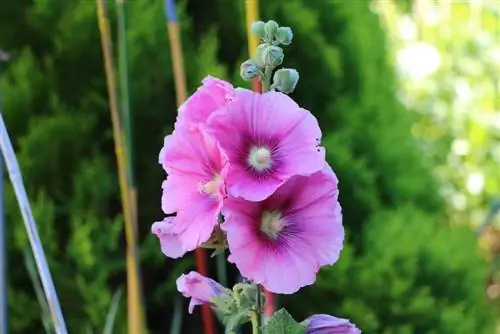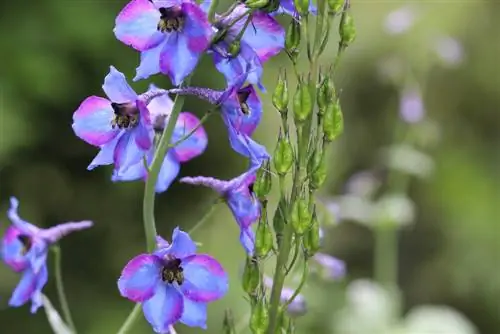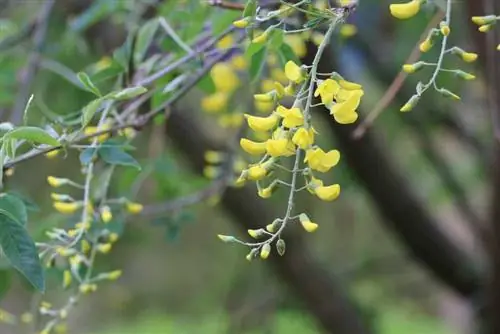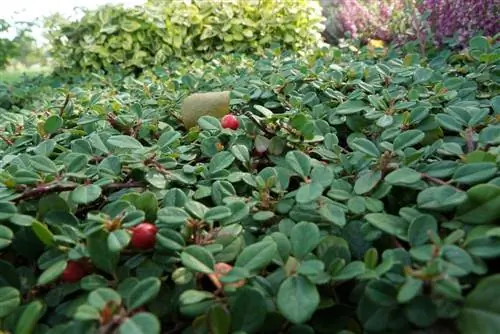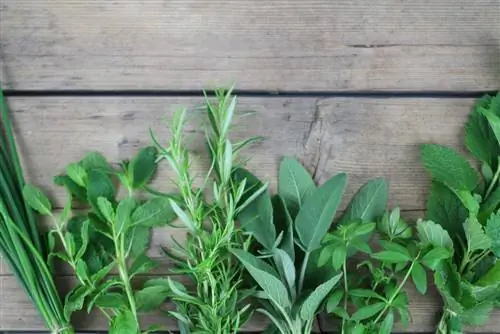- Author admin [email protected].
- Public 2023-12-17 03:39.
- Last modified 2025-01-24 12:45.
In contrast to annual summer flowers, hardy perennials beautify the garden bed for several years. There are many varieties that thrive in sunny locations and thrive there and bloom profusely.
A to G
Aquilegia (Aquilegia)
Aquilegias belong to the buttercup family and develop unusual flower shapes. That's why the plants have many strange names in the vernacular, including elf glove, fool's cap, dove flower, Venus chariot and gypsy bell. The colorful perennial provides attractive cut flowers for wildflower bouquets in early summer. With the short-growing varieties, cultivation is also possible in small-sized gardens.
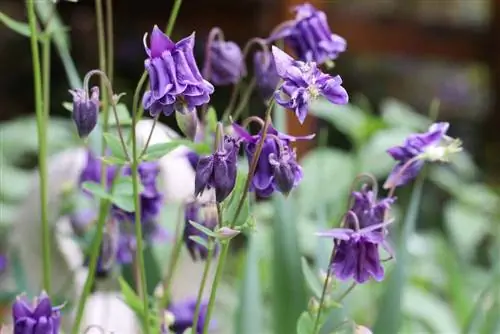
- Both tall varieties and dwarf forms
- Growth height depending on the variety from 15 to 90 cm
- Flower colors are blue, blue-violet, blue-white, yellow, red and white
- Flowering period from May to July
- Pruning after the first flowering leads to late summer rebloom
- Nutritious, fresh and humus-rich soils
- Pay attention to well-drained qualities, avoid waterlogging
- Popular varieties include Blue Star, Jewel White, Nora Barlow and William Guiness
Scented Nettle (Agastache)
The scented nettle belongs to the mint family and forms pretty flower candles. The plant captivates with a fresh scent and impresses with a very long flowering period. The flowers attract numerous insects, including busy bees. Both the flowers and leaves are edible and have an aniseed and mint-like flavor. In addition, the herbaceous plant is relatively easy to care for and robust against diseases and pests.
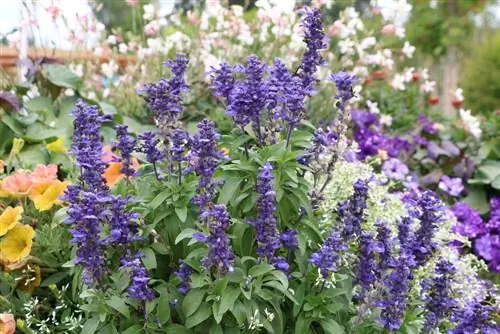
- Herbaceous and clump-forming growth
- Growth height from 30 to 50 cm, tall varieties up to 150 cm
- Produces white, pink and blue-violet flower colors
- Flowering period from June to September
- Permeable, nutrient-rich and not too moist soils
- Sandy and slightly dry substrate is ideal
- Avoid waterlogging at all costs
- Needs additional winter protection in severe frosts
Flame Flowers (Phlox)
Flame flowers are classic perennials for the cottage garden and belong to the weed family. The plants bloom colorfully and tirelessly, and they also spread a summery scent. This scent is most noticeable on hot days and in the evenings. You can choose from early, medium and late flowering varieties in many different colors that can be planted in combination. If you cut back after the first flowering, the plants will bloom again.
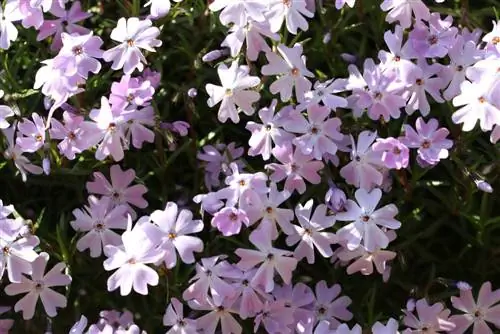
- Growth height from 70 to 100 cm
- Blue, pink, red, purple and white flowers
- Depending on the variety, mixed colored flowers are possible
- Flowering period from July to September
- Humus-rich, deep and moist clay soil is ideal
- Avoid waterlogging at all costs
- Fertilize in spring with compost or horn meal for abundant flowers
- Popular varieties are Blue Paradise, Hohe and Wiesen Flamingo
Chamoiswort (Doronicum)
Gemswurz is an abundantly flowering perennial whose flowers are similar to daisies. The short-growing varieties fit well in the front areas of the garden beds and bloom early in spring. The perennials are very popular with bees and are suitable as cut flowers for the vase.

- Upright and clumpy growth
- Reaches heights of 15 to 60 cm
- Yellow and radial flowers
- Flowering time is from April to May
- Permeable, sandy-loamy and fresh soils are ideal
- Lime-tolerant perennial plant
- Substrate must never dry out, but avoid waterlogging
- Popular varieties are Austrian Gemswurz and Gemswurz Magnificum
- Synonyms: Gemswurz and Gamswurz
K to P
Cockade flower (Gaillardia)
Cockade flowers come from the daisy family and are tirelessly flowering plants. The summer flowers show their colorful blooms for many months throughout the gardening season. Not only the garden owner is happy about this, but also insects when they are looking for food. The garden perennials form their leaf rosettes directly above the ground, from which the flower stalks then protrude.
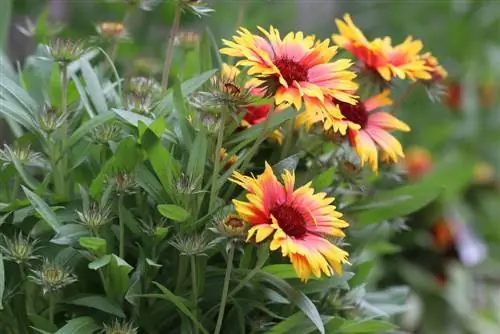
- Upright, bushy and dense growth
- Reaches heights of 15 to 75 cm, depending on the variety
- Multicolored flowers in yellow, orange and red
- Flowering period from July to October
- Moderately dry to fresh soils
- Slightly alkaline to slightly acidic pH value
- Nutritious and humus-rich substrate, loves lime
- Heavy pruning in autumn is required for winter protection
- Popular varieties are Bremen, Fanfare, Goldkobold, Tizzy and Tokajer
Lupine (Lupinus)
Lupins belong to the family of butterflies and are an ornament for every garden due to their bright colors. Each plant bears several of the showy flower stalks. Pruning after the first flowering will encourage a second bloom. In addition, the protein-rich plant is also edible.
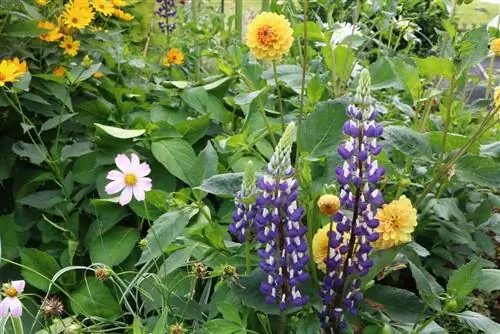
- Growth height from 80 to 100 cm
- Flowering period from June to August
- Flowers in yellow, pink, red, purple and white
- Depending on the variety, two-color variants are also possible
- Sandy, poor and moderately nutrient-rich soils are ideal
- Pay attention to permeable and low-lime qualities
- Cannot tolerate waterlogging, create drainage
- Popular varieties include yellow, narrow-leaved, multi-leaved and white lupine
Girl's Eye (Coreopsis)
The girls' eyes are also called beautiful faces and originally come from North and South America. The heat-loving perennial is known for its abundance of flowers and produces long-lasting flowers. In addition, the different varieties of the perennial bloomer shine in beautiful colors in the garden.
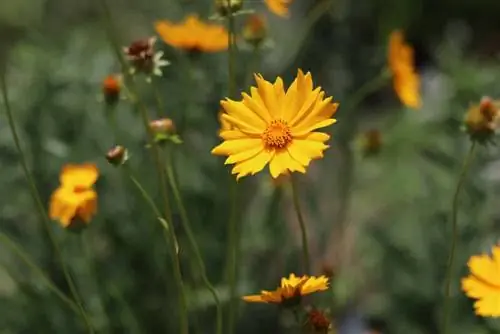
- Upright to bushy growth
- Growth heights vary between 10 and 80 cm
- Golden yellow and wheel-shaped flowers are traditional
- New varieties with red, pink and white shades
- Very long flowering period from June to October
- Need looser, humus-rich and nutrient-rich soil
- Cannot tolerate waterlogging, but can cope with dry phases
- Popular varieties are Large-flowered Girl's Eye and Early Sunrise
Palm lily (Yucca filamentosa)
The palm lily is also known as the garden yucca and belongs to the agave family. Due to the impressive inflorescences, the plant appears exotic and gives the garden bed a southern flair. The attractive solitary perennial grows strongly in width, so it needs enough space in the selected location. Otherwise, the plant is quite undemanding and thrives on almost all soils without any problems.
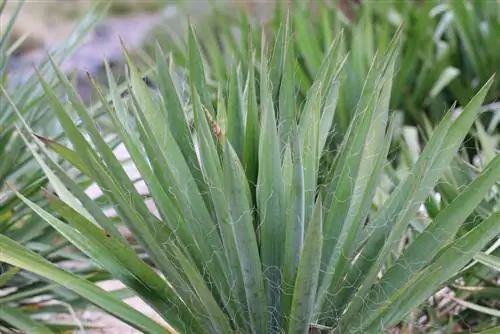
- Clust-forming growth with palm-like tuft of leaves
- Reaches heights of 80 cm to 200 cm
- Produces creamy white and bell-shaped flowers
- Flowering period from July to September
- Stony to loamy soils, dry to moderately dry
- Alkaline, neutral or slightly acidic pH value
- A nutrient-rich substrate is ideal and tolerates lime
- Fertilize in spring, cut back after flowering
- Popular varieties include Bright Edge, Polar Bear and Bellbush
R to Z
larkspur (Delphinium)
Delkspurs are one of the best-known garden perennials in this latitude. The tall-growing plants belong to the buttercup family and form branched flower panicles that grow on strong, hollow stems. The deeply cut leaves are also typical of the plants. Unfortunately, delphiniums are susceptible to powdery mildew, and they also need to be protected from voracious snails when they sprout.

- Upright and slender growth
- Reach heights of 120 to 180 cm
- Light to dark blue or purple flowers, sometimes white
- Tried variety shines in gentian blue
- Flowering period from June to September
- Pruning after main flowering stimulates secondary flowering
- Loamy, nutrient-rich and fresh soils are ideal
- Popular varieties include Atlantis, Ball Gown, Piccolo and Völkerfrieden
Rosenwaldmeister (Phuopsis stylosa)
The rose woodruff is related to the native woodruff and belongs to the reddish family. This is a ground-covering and floriferous cushion perennial that enchants with herb-scented flower balls. The plant is also very easy to care for, but it is not suitable for consumption. To ensure that the clumps sprout vigorously and grow more compactly, it is advisable to prune at the beginning of spring and immediately after flowering.

- Upright growth, forms clumps and carpets
- Reaches heights of 15 to 30 cm
- Flower color is reddish to pink
- Flowering period from June to August
- Fresh, sandy to loamy soils
- Alkaline to slightly acidic pH value
- A humus-rich substrate with lime content is ideal
- Attractive varieties include Crimson Embers and Roseum
Gypsophila (Gypsophila)
Gypsophila comes from the carnation family and is very popular in the local latitudes thanks to the large number of star flowers. It fits very well in a cottage garden or as a neighboring plant in the rose bed. Although the graceful plant looks very delicate, the gypsophila is tough and robust. The perennial is hardy, but needs additional frost protection in winter and must not be left too wet, otherwise the deep roots will begin to rot.
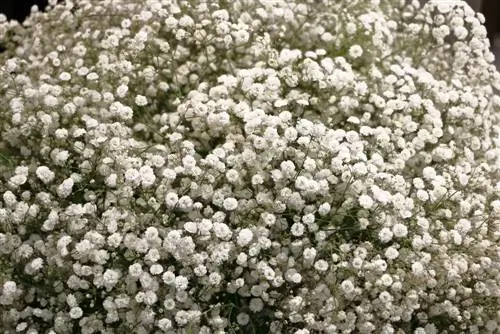
- Cut perennial with spherical growth
- Reaches heights of 25 to 90 cm depending on the variety
- Predominantly white, sometimes pink flowers
- Flowering period from June to September
- Permeable, humus-rich and loose soils
- Low-nutrient, sandy and moderately dry substrate is ideal
- Avoid waterlogging, create drainage
- Perennial varieties include Flamingo and Carpet Gypsophila
Hollyhock (Alcea)
Hollyhocks belong to the mallow family and originally come from the Mediterranean region. They have long been known as useful plants for medicinal purposes and are used to color food. Although hollyhocks are perennial and winter-hardy perennials, they put a lot of effort into flowering. That's why the blooms visibly decrease from year to year. Constant rejuvenation is possible by sowing after flowering.
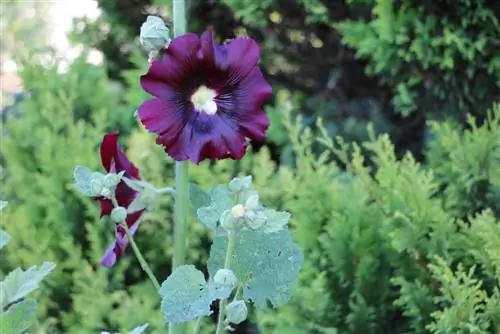
- Upright growth, produces rosettes
- Growth heights up to 200 cm possible
- Yellow, orange, red, pink, purple and white flowers
- Flowering period from July to September
- Dry to moderately moist soils
- A substrate rich in humus and nutrients is ideal
- Neutral pH value, tolerates limescale
- Protect extremely long flower stems with a sturdy rod
- The common hollyhock (Alcea rosea) is widespread
Lemon thyme (Thymus citridorus)
The name of lemon thyme already indicates its properties and characteristics. Both the leaves and flowers exude a strong, aromatic citrus scent and they also taste fruity and fresh. That's why this perennial enriches every kitchen garden and has a variety of uses in the kitchen, both in the preparation of food and drinks.
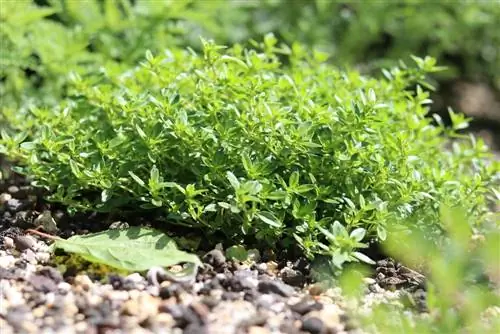
- Densely bushy growth, clump forming
- Growth height from 20 to 30 cm
- Purple to pink flowers, strongly scented
- Flowering period from June to August
- Sandy to loamy soils, dry to moderately dry
- Only moderately nutrient-rich substrate
- Alkaline to neutral pH is ideal, loves lime
- Fits well in herb and rock gardens

